2010 FORD EXPEDITION fuel pump
[x] Cancel search: fuel pumpPage 333 of 420
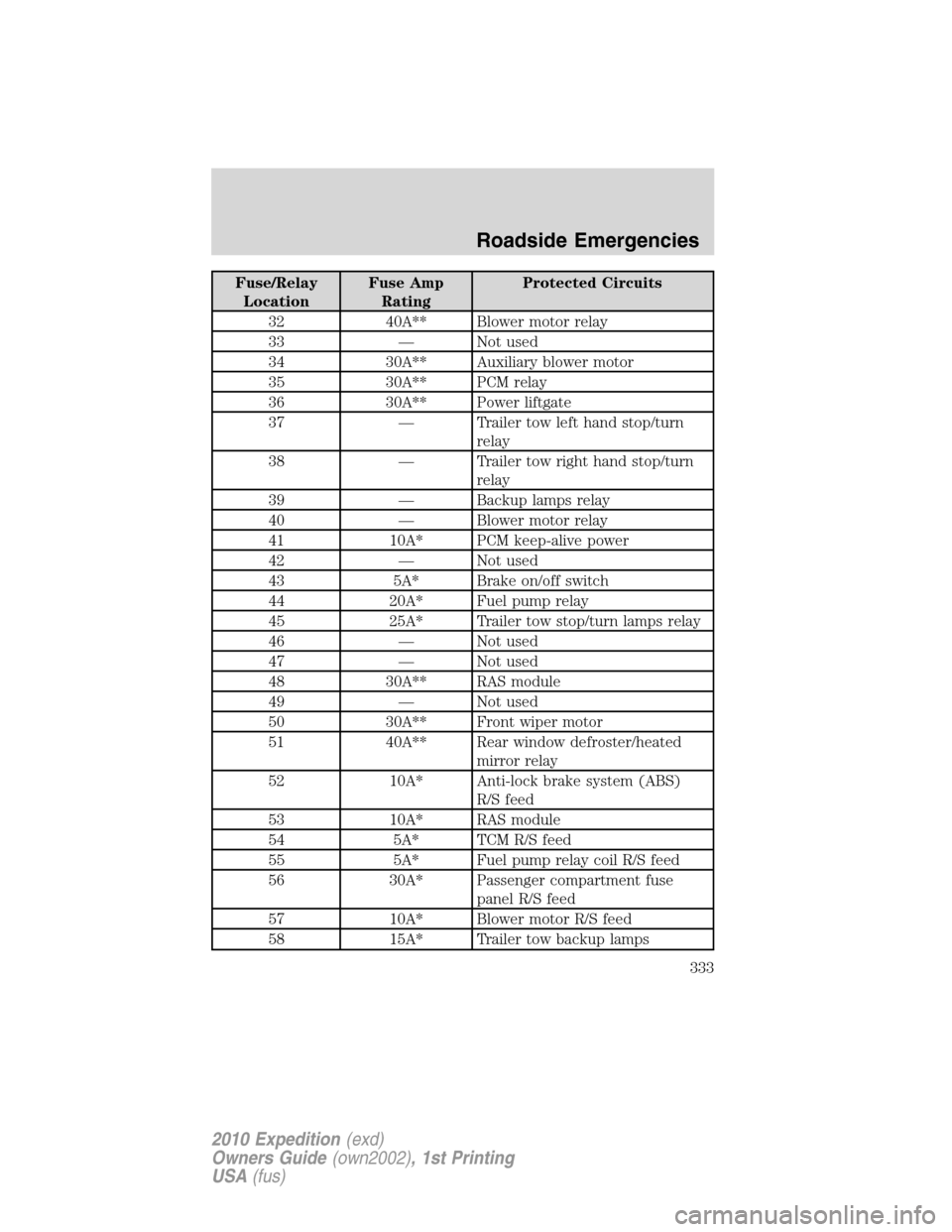
Fuse/Relay
LocationFuse Amp
RatingProtected Circuits
32 40A** Blower motor relay
33 — Not used
34 30A** Auxiliary blower motor
35 30A** PCM relay
36 30A** Power liftgate
37 — Trailer tow left hand stop/turn
relay
38 — Trailer tow right hand stop/turn
relay
39 — Backup lamps relay
40 — Blower motor relay
41 10A* PCM keep-alive power
42 — Not used
43 5A* Brake on/off switch
44 20A* Fuel pump relay
45 25A* Trailer tow stop/turn lamps relay
46 — Not used
47 — Not used
48 30A** RAS module
49 — Not used
50 30A** Front wiper motor
51 40A** Rear window defroster/heated
mirror relay
52 10A* Anti-lock brake system (ABS)
R/S feed
53 10A* RAS module
54 5A* TCM R/S feed
55 5A* Fuel pump relay coil R/S feed
56 30A* Passenger compartment fuse
panel R/S feed
57 10A* Blower motor R/S feed
58 15A* Trailer tow backup lamps
Roadside Emergencies
333
2010 Expedition(exd)
Owners Guide(own2002), 1st Printing
USA(fus)
Page 334 of 420
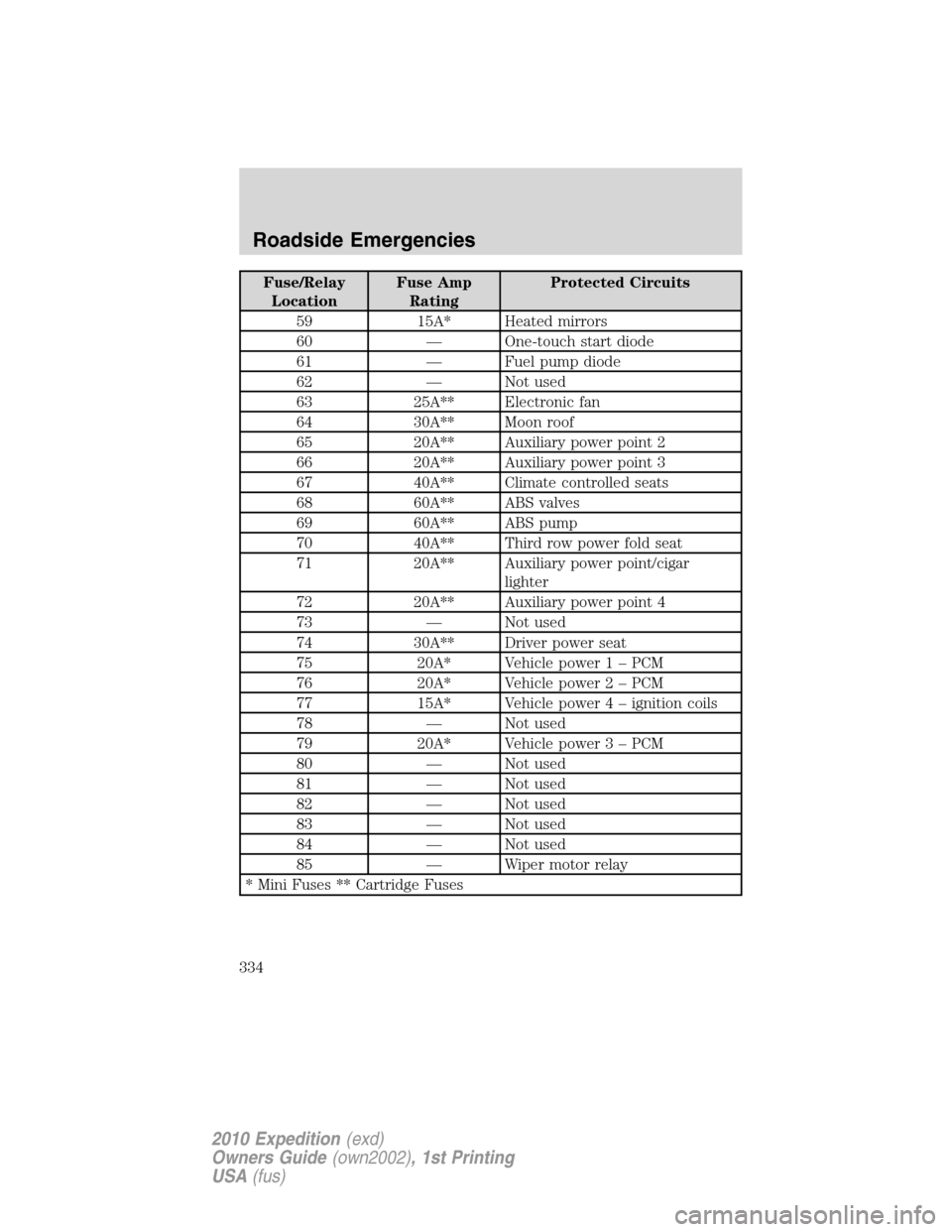
Fuse/Relay
LocationFuse Amp
RatingProtected Circuits
59 15A* Heated mirrors
60 — One-touch start diode
61 — Fuel pump diode
62 — Not used
63 25A** Electronic fan
64 30A** Moon roof
65 20A** Auxiliary power point 2
66 20A** Auxiliary power point 3
67 40A** Climate controlled seats
68 60A** ABS valves
69 60A** ABS pump
70 40A** Third row power fold seat
71 20A** Auxiliary power point/cigar
lighter
72 20A** Auxiliary power point 4
73 — Not used
74 30A** Driver power seat
75 20A* Vehicle power1–PCM
76 20A* Vehicle power2–PCM
77 15A* Vehicle power4–ignition coils
78 — Not used
79 20A* Vehicle power3–PCM
80 — Not used
81 — Not used
82 — Not used
83 — Not used
84 — Not used
85 — Wiper motor relay
* Mini Fuses ** Cartridge Fuses
Roadside Emergencies
334
2010 Expedition(exd)
Owners Guide(own2002), 1st Printing
USA(fus)
Page 386 of 420

WARNING:When refueling always shut the engine off and
never allow sparks or open flames near the filler neck. Never
smoke while refueling. Fuel vapor is extremely hazardous under certain
conditions. Care should be taken to avoid inhaling excess fumes.
WARNING:The flow of fuel through a fuel pump nozzle can
produce static electricity, which can cause a fire if fuel is
pumped into an ungrounded fuel container.
Refueling
WARNING:Fuel vapor burns violently and a fuel fire can cause
severe injuries. To help avoid injuries to you and others:
•Read and follow all the instructions on the pump island;
•Turn off your engine when you are refueling;
•Do not smoke if you are near fuel or refueling your vehicle;
•Keep sparks, flames and smoking materials away from fuel;
•Stay outside your vehicle and do not leave the fuel pump unattended
when refueling your vehicle — this is against the law in some places;
•Keep children away from the fuel pump; never let children pump
fuel.
Use the following guidelines to avoid electrostatic charge build-up when
filling an ungrounded fuel container:
•Place approved fuel container on the ground.
•DO NOT fill a fuel container while it is in the vehicle (including the
cargo area).
•Keep the fuel pump nozzle in contact with the fuel container while
filling.
•DO NOT use a device that would hold the fuel pump handle in the fill
position.
Easy Fuel™ “no cap” fuel system
Your fuel tank is equipped with an Easy Fuel™ “no cap” fuel filler
system. This allows you to simply open the fuel filler door and insert the
fuel filler nozzle into the fuel system. The Easy Fuel™ system is
self-sealing and protected against dust, dirt, water and snow/ice.
Maintenance and Specifications
386
2010 Expedition(exd)
Owners Guide(own2002), 1st Printing
USA(fus)
Page 387 of 420
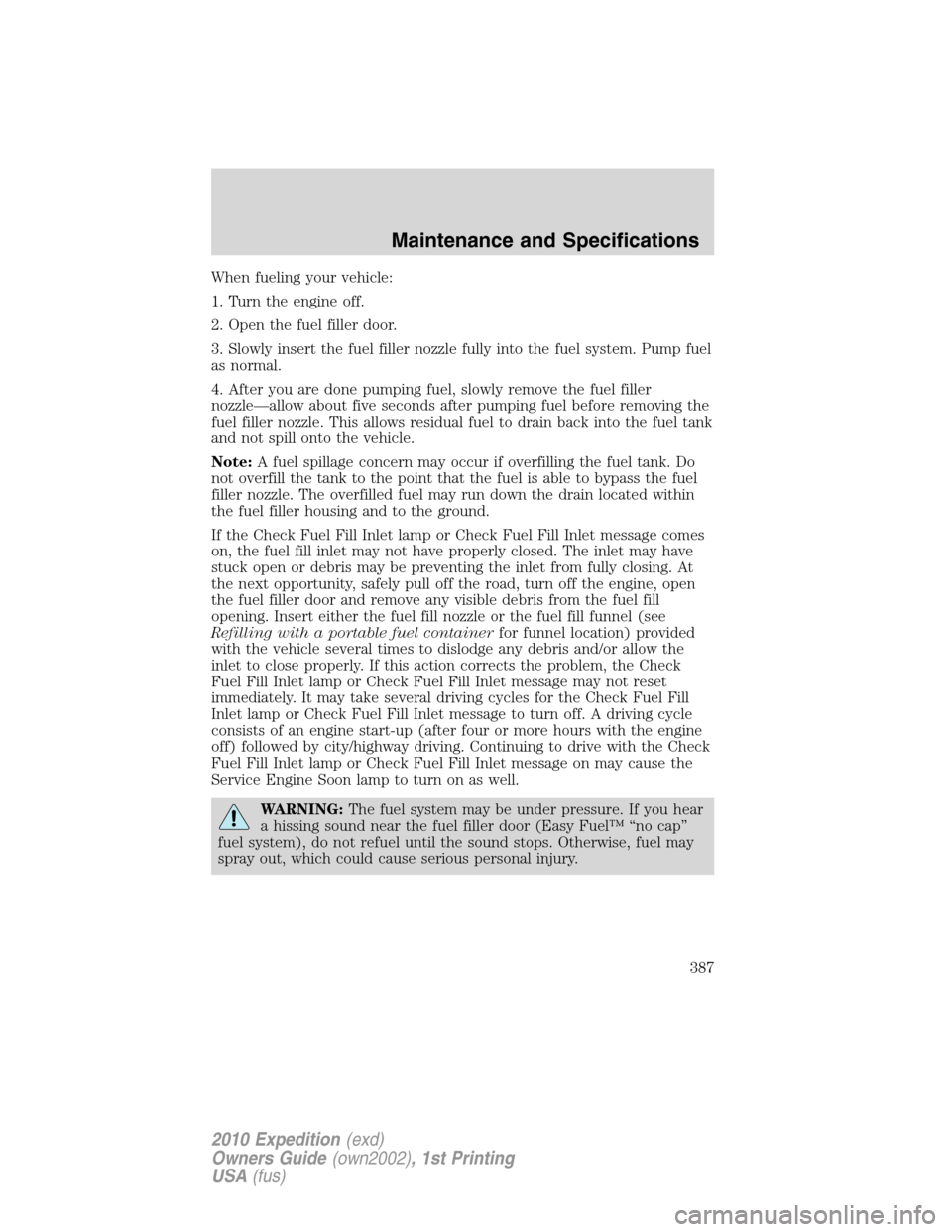
When fueling your vehicle:
1. Turn the engine off.
2. Open the fuel filler door.
3. Slowly insert the fuel filler nozzle fully into the fuel system. Pump fuel
as normal.
4. After you are done pumping fuel, slowly remove the fuel filler
nozzle—allow about five seconds after pumping fuel before removing the
fuel filler nozzle. This allows residual fuel to drain back into the fuel tank
and not spill onto the vehicle.
Note:A fuel spillage concern may occur if overfilling the fuel tank. Do
not overfill the tank to the point that the fuel is able to bypass the fuel
filler nozzle. The overfilled fuel may run down the drain located within
the fuel filler housing and to the ground.
If the Check Fuel Fill Inlet lamp or Check Fuel Fill Inlet message comes
on, the fuel fill inlet may not have properly closed. The inlet may have
stuck open or debris may be preventing the inlet from fully closing. At
the next opportunity, safely pull off the road, turn off the engine, open
the fuel filler door and remove any visible debris from the fuel fill
opening. Insert either the fuel fill nozzle or the fuel fill funnel (see
Refilling with a portable fuel containerfor funnel location) provided
with the vehicle several times to dislodge any debris and/or allow the
inlet to close properly. If this action corrects the problem, the Check
Fuel Fill Inlet lamp or Check Fuel Fill Inlet message may not reset
immediately. It may take several driving cycles for the Check Fuel Fill
Inlet lamp or Check Fuel Fill Inlet message to turn off. A driving cycle
consists of an engine start-up (after four or more hours with the engine
off) followed by city/highway driving. Continuing to drive with the Check
Fuel Fill Inlet lamp or Check Fuel Fill Inlet message on may cause the
Service Engine Soon lamp to turn on as well.
WARNING:The fuel system may be under pressure. If you hear
a hissing sound near the fuel filler door (Easy Fuel™ “no cap”
fuel system), do not refuel until the sound stops. Otherwise, fuel may
spray out, which could cause serious personal injury.
Maintenance and Specifications
387
2010 Expedition(exd)
Owners Guide(own2002), 1st Printing
USA(fus)
Page 388 of 420

Flex Fuel Vehicle (FFV) fuel fill inlet
Flex fuel vehicles have a yellow bezel placed over the fuel fill inlet.
Choosing the right fuel
Use only UNLEADED FUEL and FUEL ETHANOL (Ed75–Ed85).
The use of leaded fuel is prohibited by law and could damage your
vehicle.
Your vehicle was not designed to use fuel or fuel additives with metallic
compounds, including manganese-based additives.
Note:Use of any fuel other than those recommended may cause
powertrain damage, a loss of vehicle performance, and repairs may not
be covered under warranty.
Octane recommendations
Your vehicle is designed to use “Regular” unleaded gasoline with a pump
(R+M)/2 octane rating of 87. Some stations offer fuels posted as
“Regular” with an octane rating below 87, particularly in high altitude
areas. Fuels with octane levels below 87 are not recommended.
Do not be concerned if your engine
sometimes knocks lightly. However,
if it knocks heavily under most
driving conditions while you are
using fuel with the recommended
octane rating, see your authorized dealer to prevent any engine damage.
FFV engines
Your vehicle is designed to use Fuel Ethanol (Ed75–Ed85),“Regular”
unleaded gasoline or any mixture of the two fuels.
Use of other fuels such as Fuel Methanol may cause powertrain
damage, a loss of vehicle performance, and your warranty may be
invalidated.
87(R+M)/2 METHOD
Maintenance and Specifications
388
2010 Expedition(exd)
Owners Guide(own2002), 1st Printing
USA(fus)
Page 389 of 420
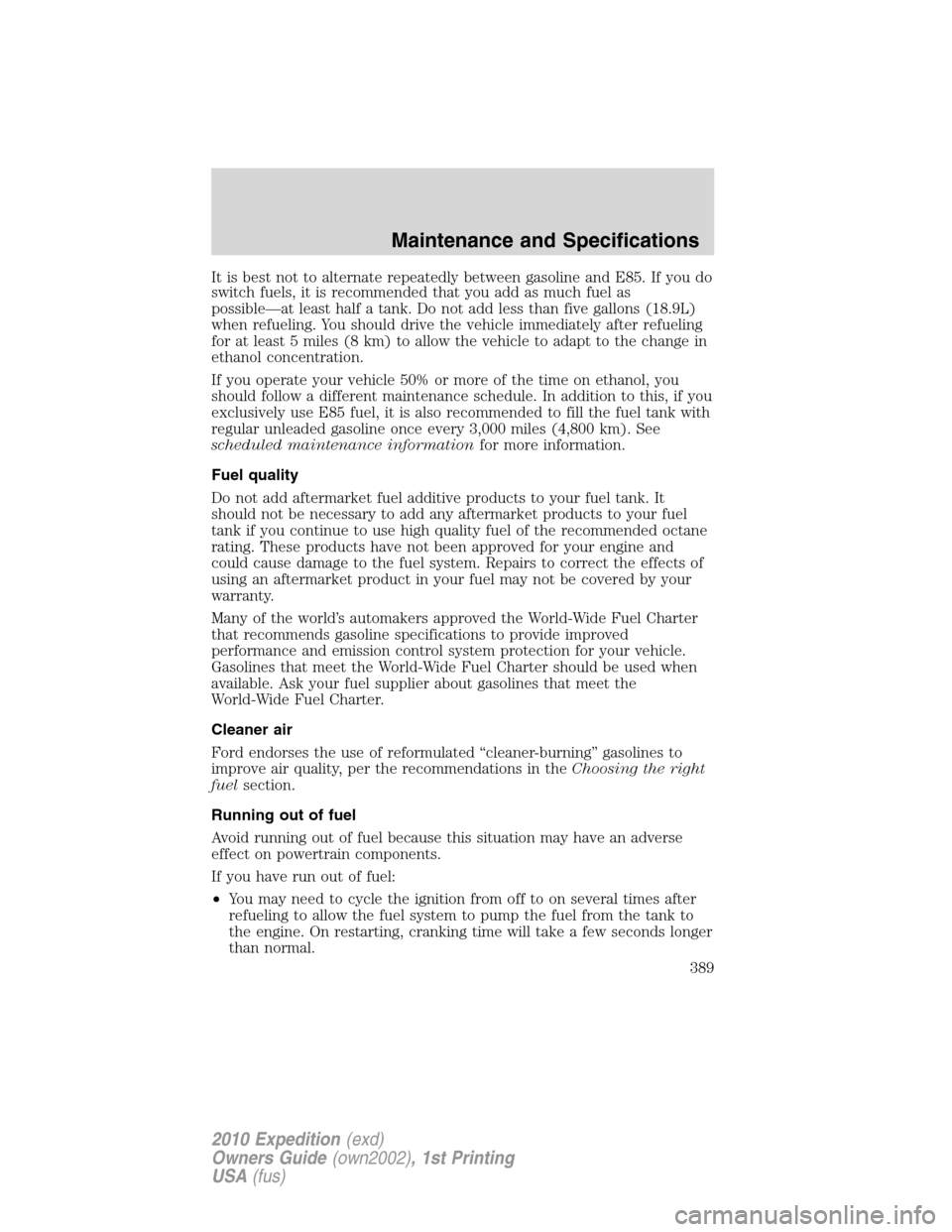
It is best not to alternate repeatedly between gasoline and E85. If you do
switch fuels, it is recommended that you add as much fuel as
possible—at least half a tank. Do not add less than five gallons (18.9L)
when refueling. You should drive the vehicle immediately after refueling
for at least 5 miles (8 km) to allow the vehicle to adapt to the change in
ethanol concentration.
If you operate your vehicle 50% or more of the time on ethanol, you
should follow a different maintenance schedule. In addition to this, if you
exclusively use E85 fuel, it is also recommended to fill the fuel tank with
regular unleaded gasoline once every 3,000 miles (4,800 km). See
scheduled maintenance informationfor more information.
Fuel quality
Do not add aftermarket fuel additive products to your fuel tank. It
should not be necessary to add any aftermarket products to your fuel
tank if you continue to use high quality fuel of the recommended octane
rating. These products have not been approved for your engine and
could cause damage to the fuel system. Repairs to correct the effects of
using an aftermarket product in your fuel may not be covered by your
warranty.
Many of the world’s automakers approved the World-Wide Fuel Charter
that recommends gasoline specifications to provide improved
performance and emission control system protection for your vehicle.
Gasolines that meet the World-Wide Fuel Charter should be used when
available. Ask your fuel supplier about gasolines that meet the
World-Wide Fuel Charter.
Cleaner air
Ford endorses the use of reformulated “cleaner-burning” gasolines to
improve air quality, per the recommendations in theChoosing the right
fuelsection.
Running out of fuel
Avoid running out of fuel because this situation may have an adverse
effect on powertrain components.
If you have run out of fuel:
•You may need to cycle the ignition from off to on several times after
refueling to allow the fuel system to pump the fuel from the tank to
the engine. On restarting, cranking time will take a few seconds longer
than normal.
Maintenance and Specifications
389
2010 Expedition(exd)
Owners Guide(own2002), 1st Printing
USA(fus)
Page 391 of 420
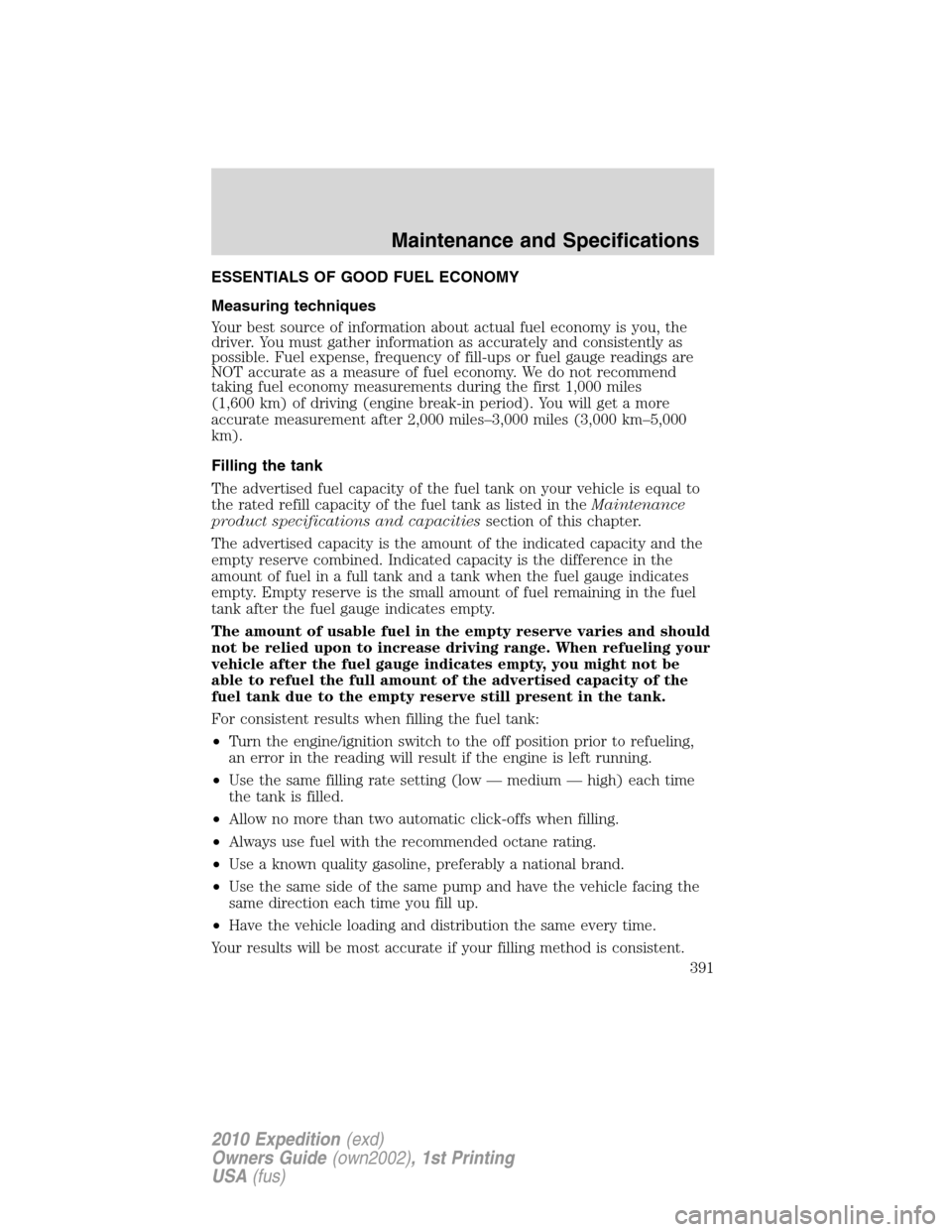
ESSENTIALS OF GOOD FUEL ECONOMY
Measuring techniques
Your best source of information about actual fuel economy is you, the
driver. You must gather information as accurately and consistently as
possible. Fuel expense, frequency of fill-ups or fuel gauge readings are
NOT accurate as a measure of fuel economy. We do not recommend
taking fuel economy measurements during the first 1,000 miles
(1,600 km) of driving (engine break-in period). You will get a more
accurate measurement after 2,000 miles–3,000 miles (3,000 km–5,000
km).
Filling the tank
The advertised fuel capacity of the fuel tank on your vehicle is equal to
the rated refill capacity of the fuel tank as listed in theMaintenance
product specifications and capacitiessection of this chapter.
The advertised capacity is the amount of the indicated capacity and the
empty reserve combined. Indicated capacity is the difference in the
amount of fuel in a full tank and a tank when the fuel gauge indicates
empty. Empty reserve is the small amount of fuel remaining in the fuel
tank after the fuel gauge indicates empty.
The amount of usable fuel in the empty reserve varies and should
not be relied upon to increase driving range. When refueling your
vehicle after the fuel gauge indicates empty, you might not be
able to refuel the full amount of the advertised capacity of the
fuel tank due to the empty reserve still present in the tank.
For consistent results when filling the fuel tank:
•Turn the engine/ignition switch to the off position prior to refueling,
an error in the reading will result if the engine is left running.
•Use the same filling rate setting (low — medium — high) each time
the tank is filled.
•Allow no more than two automatic click-offs when filling.
•Always use fuel with the recommended octane rating.
•Use a known quality gasoline, preferably a national brand.
•Use the same side of the same pump and have the vehicle facing the
same direction each time you fill up.
•Have the vehicle loading and distribution the same every time.
Your results will be most accurate if your filling method is consistent.
Maintenance and Specifications
391
2010 Expedition(exd)
Owners Guide(own2002), 1st Printing
USA(fus)
Page 416 of 420
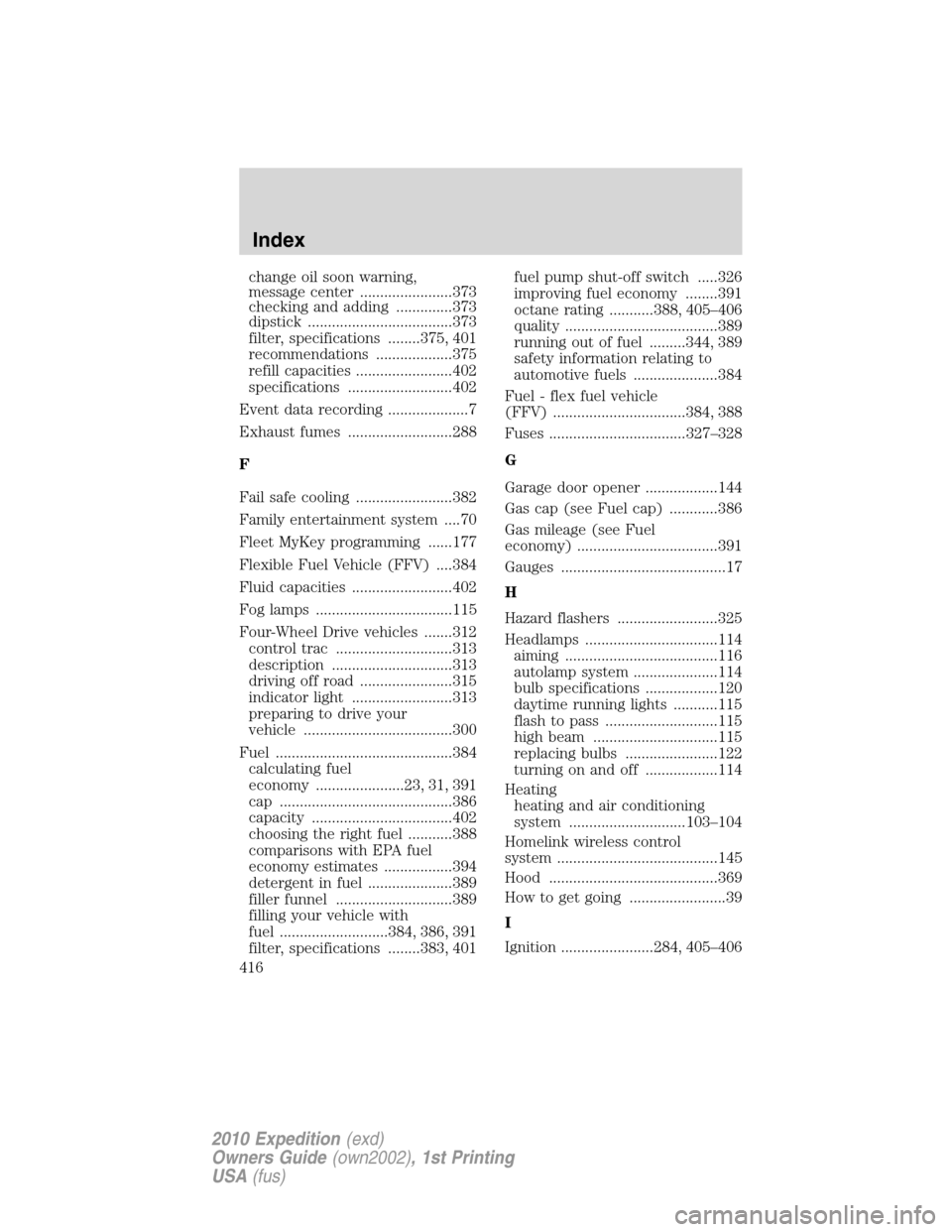
change oil soon warning,
message center .......................373
checking and adding ..............373
dipstick ....................................373
filter, specifications ........375, 401
recommendations ...................375
refill capacities ........................402
specifications ..........................402
Event data recording ....................7
Exhaust fumes ..........................288
F
Fail safe cooling ........................382
Family entertainment system ....70
Fleet MyKey programming ......177
Flexible Fuel Vehicle (FFV) ....384
Fluid capacities .........................402
Fog lamps ..................................115
Four-Wheel Drive vehicles .......312
control trac .............................313
description ..............................313
driving off road .......................315
indicator light .........................313
preparing to drive your
vehicle .....................................300
Fuel ............................................384
calculating fuel
economy ......................23, 31, 391
cap ...........................................386
capacity ...................................402
choosing the right fuel ...........388
comparisons with EPA fuel
economy estimates .................394
detergent in fuel .....................389
filler funnel .............................389
filling your vehicle with
fuel ...........................384, 386, 391
filter, specifications ........383, 401fuel pump shut-off switch .....326
improving fuel economy ........391
octane rating ...........388, 405–406
quality ......................................389
running out of fuel .........344, 389
safety information relating to
automotive fuels .....................384
Fuel - flex fuel vehicle
(FFV) .................................384, 388
Fuses ..................................327–328
G
Garage door opener ..................144
Gas cap (see Fuel cap) ............386
Gas mileage (see Fuel
economy) ...................................391
Gauges .........................................17
H
Hazard flashers .........................325
Headlamps .................................114
aiming ......................................116
autolamp system .....................114
bulb specifications ..................120
daytime running lights ...........115
flash to pass ............................115
high beam ...............................115
replacing bulbs .......................122
turning on and off ..................114
Heating
heating and air conditioning
system .............................103–104
Homelink wireless control
system ........................................145
Hood ..........................................369
How to get going ........................39
I
Ignition .......................284, 405–406
Index
416
2010 Expedition(exd)
Owners Guide(own2002), 1st Printing
USA(fus)